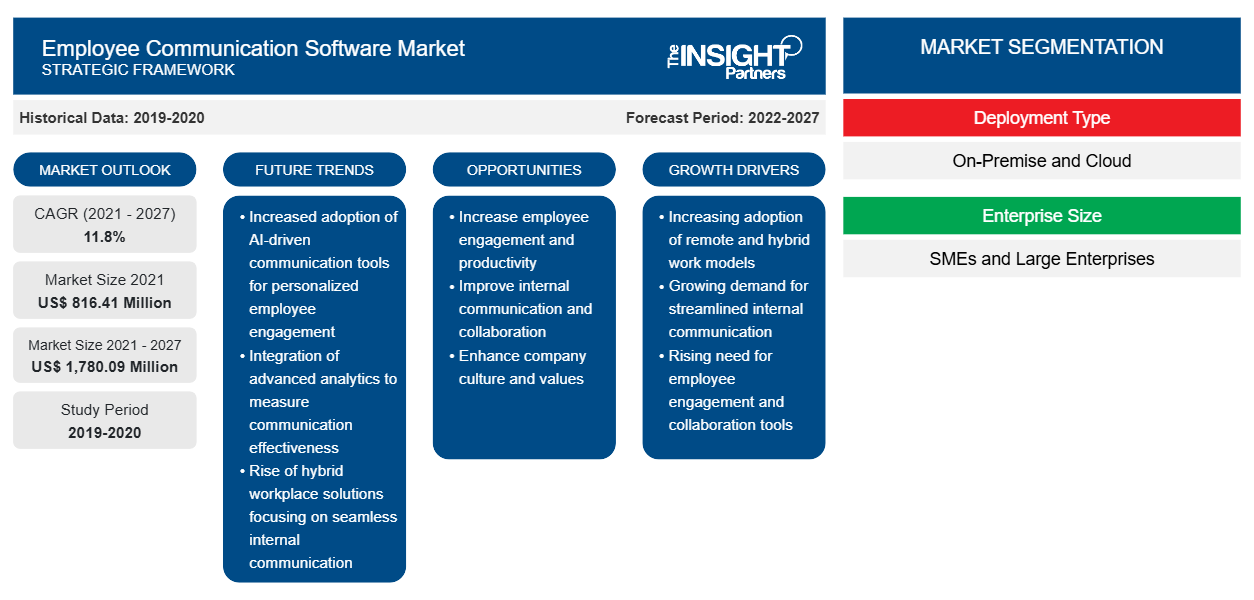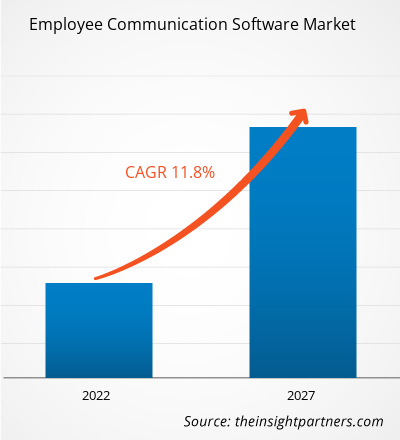The employee communication software market is expected to grow from US$ 816.41 million in 2021 to US$ 1,780.09 million by 2027. The employee communication software market is expected to grow at a CAGR of 11.8% during the forecast period of 2021 to 2027.
With increasing competitiveness across industries, the need for high operational and employee productivity is growing among enterprises for sustainable and profitable long term growth. Hence, the demand for efficient and effective employee communication solutions is rising at an impressive pace across industries such as BFSI, manufacturing, retail, healthcare, IT & telecom, education, and others. Internal organizational communication plays a crucial role in driving collaboration, productivity, and workforce engagement in an enterprise. In addition to this, the crucial need to maintain proper communication with deskless employees and growing share of remote workforce owing to ongoing coronavirus outbreak are some of the important factors that are boosting the adoption of employee communication software and services globally. There are several innovative companies that are offering these solutions with a wide variety of features integrated in them. An employee communication software allows organizations to customize and offer targeted communications across departments such as internal communications, HR communications, operational messages, compliance communications, and emergency notifications among others. These solutions also offer high level of personalization and employee engagement tools to support holistic communication development across the enterprise. The rising trend of digitalization, growing demand for outcome-based communication solutions, and increasing adoption of cloud-based solutions across small, medium, and large sized enterprises are some of the key driving factors for the growth of employee communication software market.
The market for employee communication software is segmented into deployment type, enterprise size, industry, and geography. Based on deployment type, the employee communication software market is divided into cloud and on-premise. Cloud segment is projected to be the largest and fastest growing segment over the forecast from 2021 to 2027. On the basis of enterprise size, the market is segmented into SMEs and large enterprises. The large enterprises segment contributed the largest revenue share in 2019 whereas SMEs segment is projected to be the fastest growing sector in terms of growth rate. On basis of industry, the market is segmented into BFSI, manufacturing, retail, healthcare, IT & telecom and others. In 2020, IT and telecom industry led the employee communication software market globally. Geographically, the market is segmented into five major regions, namely North America, Europe, APAC, MEA and SAM. In 2019, North America held the largest revenue share followed by Europe and APAC.
Customize This Report To Suit Your Requirement
You will get customization on any report - free of charge - including parts of this report, or country-level analysis, Excel Data pack, as well as avail great offers and discounts for start-ups & universities
Employee Communication Software Market: Strategic Insights

-
Get Top Key Market Trends of this report.This FREE sample will include data analysis, ranging from market trends to estimates and forecasts.
Employee communication software Market Insights
Increasing Need for Enhanced Communication with Deskless Workforce to Drive the Demand
With increasing level of competition and changing technology landscape across industry verticals, companies are continuously striving for solutions that could help in enhancing employee productivity, operational efficiency, and end user experiences, while reducing their overall costs. In addition to this, due to coronavirus outbreak, companies are also shifting towards remote working culture owing to restrictions on on-premise business activities and movement restrictions being implemented in various countries. The structure of today’s enterprises is becoming more dynamic and complex, especially in industries such as retail and healthcare where a large section of workforce is deskless/mobile in nature. The coronavirus outbreak is further driving the trend of remove working in other industries also such as BFSI, manufacturing, IT and telecom among others. Hence, due to increasing share of deskless workforce across industries, the demand for multi-platform communication tools (desktop, mobile, tablets etc.) is expected to rise at an impressive rate in the coming years.
Deployment Type -Based Market Insights
Based on deployment type, the global employee communication software market is segmented into cloud and on-premise. The demand for the cloud-based employee communication software is greater than the on-premise employee communication software. The cloud-base software offerings are less expensive than the on-premise software; moreover, strong network infrastructure in developed countries also supports the adoption of cloud-based software. Various corporate players are planning to make substantial investments on advanced software to swiftly shift toward modern platforms integrated with advanced features.
Enterprise Size -Based Market Insights
Based on enterprise size, the employee communication software market is segmented into SMEs and large enterprises. The large enterprises segment led the employee communication software market with a highest share.
Industry -Based Market Insights
The end-user segment is sub-segmented into BFSI, manufacturing, retail, healthcare, IT and telecom, and other industries. The others segment include industries such as transportation, government, education, and energy etc.
Players operating in the Employee communication software market focus on strategies, such as market initiatives, acquisitions, and product launches, to maintain their positions in the employee communication software market. A few developments by key players of the employee communication software market are:
In September 2020, Smarp Oy launched an AI-powered analytics suite. This suite combines the AI and real-time analytics to measure the impact of employee communication.
In April 2020, Nudge Corporation launched a frontline activation suite of features designed to activate dormant frontline workforces. Nudge helps to navigate four key recovery stages, including field execution, recruitment, onboarding, and sustained performance, that advance existing benchmarks for employee engagement.
Employee Communication Software Market Regional InsightsThe regional trends and factors influencing the Employee Communication Software Market throughout the forecast period have been thoroughly explained by the analysts at The Insight Partners. This section also discusses Employee Communication Software Market segments and geography across North America, Europe, Asia Pacific, Middle East and Africa, and South and Central America.
Employee Communication Software Market Report Scope
| Report Attribute | Details |
|---|---|
| Market size in 2021 | US$ 816.41 Million |
| Market Size by 2027 | US$ 1,780.09 Million |
| Global CAGR (2021 - 2027) | 11.8% |
| Historical Data | 2019-2020 |
| Forecast period | 2022-2027 |
| Segments Covered |
By Deployment Type
|
| Regions and Countries Covered |
North America
|
| Market leaders and key company profiles |
|
Employee Communication Software Market Players Density: Understanding Its Impact on Business Dynamics
The Employee Communication Software Market is growing rapidly, driven by increasing end-user demand due to factors such as evolving consumer preferences, technological advancements, and greater awareness of the product's benefits. As demand rises, businesses are expanding their offerings, innovating to meet consumer needs, and capitalizing on emerging trends, which further fuels market growth.

- Get the Employee Communication Software Market top key players overview
Employee Communication Software Market – By Deployment Type
- Cloud
- On-Premise
Employee Communication Software Market – by Enterprise Size
- SMEs
- Large Enterprises
Employee Communication Software Market – By Industry
- BFSI
- Manufacturing
- Retail
- Healthcare
- IT and Telecom
- Other Industries
Employee Communication Software Market – by Geography
- North America
- US
- Canada
- Mexico
- Europe
- France
- Germany
- Russia
- UK
- Italy
- Rest of Europe
- Asia Pacific (APAC)
- China
- India
- Japan
- Australia
- South Korea
- Rest of APAC
- MEA
- Saudi Arabia
- UAE
- South Africa
- Rest of MEA
- SAM
- Brazil
- Argentina
- Rest of SAM
Employee Communication Software Market – Company Profiles
- Beekeeper AG
- Nudge Corporation
- Poppulo (E-Search DAC)
- Simpplr Inc.
- Smarp Oy
- SnapComms
- Sociabble, Inc.
- Staffbase
- theEMPLOYEEapp
- Workvivo Limited
Frequently Asked Questions
Which enterprise size segment led the employee communication software market in 2019?
Which region led the employee communication software market?
Which factors are driving growth of the employee communication software market?
- Historical Analysis (2 Years), Base Year, Forecast (7 Years) with CAGR
- PEST and SWOT Analysis
- Market Size Value / Volume - Global, Regional, Country
- Industry and Competitive Landscape
- Excel Dataset
Recent Reports
Related Reports
Testimonials
Reason to Buy
- Informed Decision-Making
- Understanding Market Dynamics
- Competitive Analysis
- Identifying Emerging Markets
- Customer Insights
- Market Forecasts
- Risk Mitigation
- Boosting Operational Efficiency
- Strategic Planning
- Investment Justification
- Tracking Industry Innovations
- Aligning with Regulatory Trends





















 Get Free Sample For
Get Free Sample For